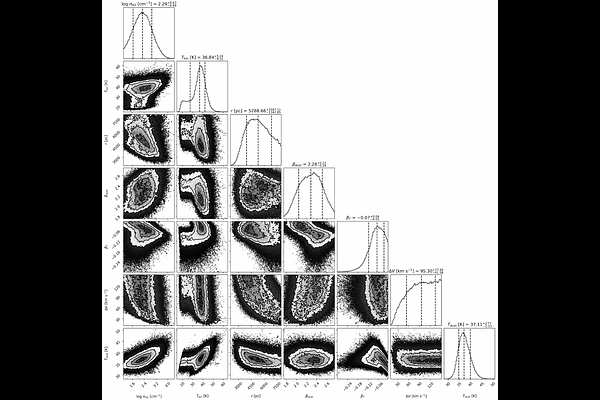Hiding behind a curtain of dust: Gas and dust properties of an ultra-luminous strongly-lensed z = 3.75 galaxy behind the Milky Way disk

Hiding behind a curtain of dust: Gas and dust properties of an ultra-luminous strongly-lensed z = 3.75 galaxy behind the Milky Way disk
Belén Alcalde Pampliega, Kevin C. Harrington, Aristeidis Amvrosiadis, Manuel Aravena, Min S. Yun, Hugo Messias, Antonio Hernán-Caballero, Leindert Boogaard, Axel Weiß, Benjamin Beauchesne, Alejandro Santamaría-Miranda, Monica Ivette Rodriguez, Eric Jiménez-Andrade, Manuel Solimano, James Lowenthal, Pascale Hibon, Patrick Kamieneski, Daniel Wang, Amit Vishwas, Brenda Frye, Jorge González-Lopez, Chentao Yang, Yiqing Song, Meghana Killi
AbstractWe present a detailed analysis of J154506, a strongly lensed submillimeter galaxy (SMG) behind the Lupus-I molecular cloud, and characterization of its physical properties. Using a combination of archival and new data (including sub-arcsecond resolution ($\sim0.75$) ALMA observations, VLT/MUSE and FORS2 optical data, as well as spectral scans from the ACA and the LMT) we identify two high-significance (SNR>5) emission lines at 97.0 and 145.5 GHz, corresponding to CO(4-3) and CO(6-5), respectively. These detections yield a spectroscopic redshift of $z_{\rm{spec}}=3.7515\pm 0.0005$. We also report the detection of the [CII] 158 $\mu$m fine-structure line at 400 GHz using the Atacama Pathfinder Experiment (APEX), further confirming the redshift and providing insights into J154506's physical properties. By modeling ALMA Band 6 and 7 continuum data in the uv-plane, we derive an average magnification factor of $6.0 \pm 0.4$ and our analysis reveals a relatively cold dust ($\sim$37 K) in a starburst galaxy with a high intrinsic dust mass ($\sim2.5\times10^{9}~\rm{M}_{\odot}$) and infrared (IR) luminosity ($\sim6\times10^{12}~\rm{L}_{\odot}$). The dust SED is best reproduced by a model dominated by moderately dense molecular gas ($10^2-10^4\rm{cm}^{-3}$), indicating that the far-infrared emission arises primarily from diffuse regions rather than compact, high-pressure environments typical of extreme starbursts or AGN. This is supported by the close-to-unity ratio between the dust and kinetic temperatures, which argues against highly energetic heating mechanisms. The CO excitation ladder peaks close to CO(5-4) and is dominated by slightly denser molecular gas. Our results underscore the unique power of far-IR and submillimeter observations to both uncover and characterize scarce, strongly lensed, high-redshift galaxies, even when obscured by foreground molecular clouds.